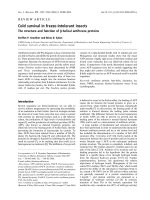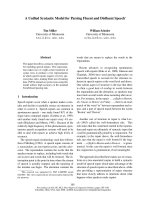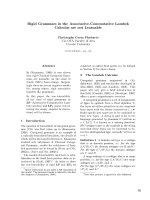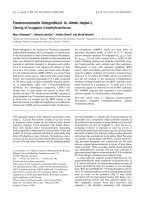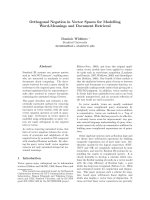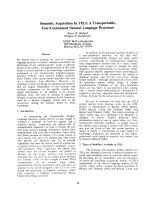Báo cáo khoa học: "Orthogonal Negation in Vector Spaces for Modelling Word-Meanings and Document Retrieval" ppt
Bạn đang xem bản rút gọn của tài liệu. Xem và tải ngay bản đầy đủ của tài liệu tại đây (133.94 KB, 8 trang )
Orthogonal Negation in Vector Spaces for Modelling
Word-Meanings and Document Retrieval
Dominic Widdows
∗
Stanford University
Abstract
Standard IR systems can process queries
such as “ web NOT internet”, enabling users
who are interested in arachnids to avoid
documents about computing. The docu-
ments retrieved for such a query should be
irrelevant to the negated query term. Most
systems implement this by reprocessing re-
sults after retrieval to remove documents
containing the unwanted string of letters.
This paper describes and evaluates a the-
oretically motivated method for removing
unwanted meanings directly fro m the orig-
inal query in vector models, with the same
vector negation operator as used in quan-
tum logic. Irrelevance in vector space s is
modelled using o rthogonality, so query vec-
tors are made orthogonal to the negated
term or terms.
As well as removing unwanted terms, this
form of vector negation reduces the occur-
rence of synonyms and neighbours of the
negated terms by as much as 76% compared
with standard Boolean methods. By alter-
ing the query vector itself, vector negatio n
removes not only unwanted strings but un-
wanted meanings.
1 Introduction
Vector spaces enjoy widespread use in information
retrieval (Salton and McGill, 1983; Baeza -Yates and
∗
This research was supported in part by the Research
Collaboration between the NTT Communication Science
Laboratories, Nippon Telegraph and Telephone Corpo-
ration and CSLI, Stanford University, and by EC/NSF
grant IST-1999-11438 for the MUCHMORE project.
Ribiero-Neto, 1999), and from this original appli-
cation vector models have been applied to seman-
tic tasks such as word-sense acquisition (Landauer
and Dumais, 1997 ; Widdows, 2003) and disambigua-
tion (Sch¨utze, 1998). One benefit of these models is
that the similarity between pairs of terms or between
queries and documents is a continuous function, au-
tomatically ranking results rather than giving just a
YES/NO judgment. In addition, vector models can
be freely built from unlabelled text and so are both
entirely unsupervised, and an accurate reflection of
the way words are used in practice.
In vector models, terms are usually combined
to form more complicated query statements by
(weighted) vector addition. Because vector addition
is commutative, terms are combined in a “bag of
words” fashion. While this has proved to be effective,
it certainly leaves room for improvement: any gen-
uine natural language understanding of query state-
ments cannot rely solely o n commutative addition for
building more complicated expressions out of primi-
tives.
Other algebraic systems such as Boolean logic and
set theory have well-known o perations for building
composite expressio ns o ut of more basic ones. Set-
theoretic models for the logical connectives ‘AND’,
‘NOT’ and ‘OR’ are completely understood by most
researchers, a nd used by Boolean I R systems for as-
sembling the results to complicated queries. It is
clearly des irable to develop a calculus which com-
bines the flexible ranking of results in a vector model
with the crisp efficiency of Boolean logic, a go al
which has lo ng been recognised (Salton et al., 1983)
and attempted mainly for conjunction and disjunc-
tion. This paper proposes such a scheme for nega-
tion, based upon well-known linear algebra, and
which also implies a vector form of disjunction. It
turns out that these vector connectives a re precisely
those used in quantum logic (Birkhoff and von Neu-
mann, 1936), a development which is dis c ussed in
much more detail in (Widdows and Peters, 2003).
Because of its simplicity, our model is easy to under-
stand and to implement.
Vector negation is based on the intuition that un-
related meanings should be orthogonal to one an-
other, which is to say that they should have no fea-
tures in common at all. Thus vector negation gener-
ates a ‘meaning vector’ w hich is completely orthog-
onal to the negated term. Document retrieval ex-
periments demonstrate that vector negation is not
only effective at removing unwanted terms: it is
also more effective than other methods at removing
their synonyms and re lated terms. This justifies the
claim that, by producing a single query vector for
“a NOT b”, we remove not only unwanted strings
but also unwanted meanings.
We describe the underlying motivation behind this
model and define the vector negation and disjunc-
tion operations in Section 2. In Section 3 we re-
view other ways negation is implemented in Infor-
mation Retrieval, comparing and contrasting with
vector negation. In Section 4 we desc ribe experi-
ments demonstrating the benefits and drawbacks of
vector negatio n compared with two other methods
for negation.
2 Negation and Disjunction in
Vector Spaces
In this section we use well-known linear algebra to
define vector negation in terms of orthogonality and
disjunction as the linear sum of subspaces. The
mathematical apparatus is covered in greater detail
in (Widdows and Peters, 2003). If A is a set (in
some universe of discours e U ), then ‘NOT A’ corre-
sp onds to the complement A
⊥
of the set A in U (by
definition). By a simple analogy, let A be a vector
subspace o f a vector space V (equipped with a scalar
product). Then the concept ‘NOT A’ should corre-
sp ond to the orthogonal complement A
⊥
of A under
the scalar product (Birkhoff and von Neumann, 1936,
§6). If we think of a basis for V as a set of features,
this says that ‘NOT A’ refers to the subspace of V
which has no features in common with A.
We make the following definitions. Let V be a
(real) vector space equipped with a scalar product.
We will use the notation A ≤ V to mean “A is a
vector subspa ce of V .” Fo r A ≤ V , define the or-
thogonal subspace A
⊥
to be the subspace
A
⊥
≡ {v ∈ V : ∀a ∈ A, a · v = 0}.
For the purposes of modelling word-meanings, we
might think of ‘orthogonal’ as a model for ‘com-
pletely unrelated’ (having similarity score zero).
This makes perfect sense for information retrieval,
where we assume (for example) that if two words
never o c c ur in the same document then they have no
features in common.
Definition 1 Let a, b ∈ V and A, B ≤ V . By
NOT A we mean A
⊥
and by NOT a, we mean
a
⊥
, where a = {λa : λ ∈ R} is the 1-dimensional
subspace subspace generated by a. By a NOT B we
mean the projection of a onto B
⊥
and by a NOT b
we mean the projection of a onto b
⊥
.
We now show how to use these notions to perform
calculations with individual term or query vectors in
a form which is simple to program and efficient to
run.
Theorem 1 Let a, b ∈ V . Then a NOT b is repre-
sented by the vector
a NOT b ≡ a −
a · b
|b|
2
b.
where |b|
2
= b · b is the modulus of b.
Proof. A simple proof is given in (Widdows and Pe-
ters, 2003).
For normalised vectors, Theorem 1 takes the par-
ticularly simple form
a NOT b = a − (a · b)b, (1)
which in practice is then renorma lis e d for consis-
tency. One computational benefit is tha t Theorem 1
gives a single vector for a NOT b, so finding the sim-
ilarity between any other vector and a NOT b is just
a single scalar product computation.
Disjunction is also simple to envisage, the expres-
sion b
1
OR . . . OR b
n
being modelled by the sub-
space
B = {λ
1
b
1
+ . . . + λ
n
b
n
: λ
i
∈ R}.
Theoretical motivation for this formulation can be
found in (Birkhoff and von Neumann, 1936, §1,§6)
and (Widdows and Peters, 2003): for example, B
is the smallest subspace of V which contains the set
{b
j
}.
Computing the similarity between a vector a and
this subspace B is computationally more expensive
than for the negation of Theorem 1, because the
scalar product of a with (up to) n vectors in an or-
thogonal basis for B must be computed. Thus the
gain we get by c omparing each document with the
query a NOT b using only one scalar product oper-
ation is absent for disjunction.
However, this benefit is regained in the case of
negated disjunction. Suppose we negate not only one
argument but several. If a user specifies that they
want documents related to a but not b
1
, b
2
, . . . , b
n
,
then (unless otherwise stated) it is clear that they
only want documents related to none of the un-
wanted terms b
i
(rather than, say, the average of
these terms).
This motivates a proces s which can be thought of
as a vector formulation of the classical de Morgan
equivalence ∼ a∧ ∼ b ≡∼ (a ∨ b), by which the
expression
a AND NOT b
1
AND NOT b
2
. . . AND NOT b
n
is tra ns lated to
a NOT (b
1
OR . . . OR b
n
). (2)
Using Definition 1, this expression can be modelled
with a unique vector which is orthogonal to all of
the unwanted arguments {b
1
}. However, unless the
vectors b
1
, . . . , b
n
are orthogonal (or identical), we
need to obtain an orthogonal basis for the s ubspace
b
1
OR . . . OR b
n
befo re we can implement a higher-
dimensional version of Theorem 1. This is because
the projection operators involved are in genera l non-
commutative, one of the hallmark differences be-
tween Boolean and quantum logic.
In this way vector negation generates a meaning-
vector which takes into account the similarities and
differences between the negative terms. A query for
chip NOT computer, silicon
is treated differently from a query for
chip NOT computer, potato.
Vector negation is capable of realising that for the
first query, the two negative terms are referring to
the same general topic area, but in the second case
the task is to remove radically different meanings
from the query. This technique has been used to
remove several meanings from a query iteratively, al-
lowing a us e r to ‘home in on’ the desired meaning by
systematically pruning away unwanted features.
2.1 Initial experiments modelling
word-senses
Our first exp e riments with vector nega tion were to
determine whether the negation operator could find
different senses of ambiguous words by negating a
word closely related to one o f the meanings. A vector
space model was built using Latent Semantic Analy-
sis, similar to the systems of (Landauer and Dumais,
1997; Sch¨utze, 1998). The effect of LSA is to in-
crease linear dependency between terms, and for this
reason it is likely that LSA is a crucial step in our
approach. Terms were indexed depending on their
co-occurrence with 1000 fre quent “content-bearing
words” in a 15 word context-window, giving each
term 1000 coordinates. This was reduced to 100 di-
mensions using singular value decomposition. Later
on, document vectors were assigned in the usual
manner by summation of term vectors using tf-idf
weighting (Salton and McGill, 19 83, p. 121). Vectors
were normalised, so that the standard (Euclidean)
scalar product and cosine similarity coincided. This
scalar product was used as a measure of term- term
and term-document similarity throughout our e xper-
iments. This method was used because it has been
found to be effective at producing good term-term
similarities for wor d-sense disambiguation (Sch¨utze,
1998) and automatic lexical acquisition (Widdows,
2003), and these similarities were used to generate in-
teresting queries and to judge the effectiveness of dif-
ferent forms of negation. More details on the build-
ing of this vector space model can be found in (Wid-
dows, 2 003; Widdows and Peters, 2003).
suit
suit NOT lawsuit
suit 1.000000 pants 0.810573
lawsuit 0.868791
shirt 0.807780
suits 0.807798 jacket 0.795674
plaintiff 0.717156 silk 0.781623
sued 0.706158
dress 0.778841
plaintiffs 0.697506 trousers 0.771312
suing 0.674661
sweater 0.765677
lawsuits 0.664649 wearing 0.764283
damages 0.660513
satin 0.761530
filed 0.655072
plaid 0.755880
behalf 0.650374 lace 0.755510
appeal 0.608732
worn 0.755260
Terms related to ‘suit NOT lawsuit’ (NYT data)
play
play NOT game
play 1.000000 play 0.779183
playing 0.773676 playing 0.658680
plays 0.699858 role 0.594148
played 0.684860
plays 0.581623
game 0.626796
versatility 0.485053
offensively 0.597609
played 0.479669
defensively 0.546795 roles 0.470640
preseason 0.544166
solos 0.448625
midfiel d 0.540720
lalas 0.442326
role 0.535318 onstage 0.438302
tempo 0.504522
piano 0.438175
score 0.475698 tyrone 0.437917
Terms related to ‘p lay NOT game’ (NYT data)
Table 1: First experiments with negation and word-
senses
Two early results using negation to find senses of
ambiguous words are given in Table 1, showing that
vector negation is very effective for removing the ‘le-
gal’ meaning from the word suit and the ‘sporting’
meaning from the word play, leaving respectively the
‘clothing’ and ‘performance’ meanings. Note that re-
moving a particular word also removes concepts re-
lated to the negated word. This gives credence to
the claim that our mathematical model is removing
the meaning of a word, rather than just a string o f
characters. This encouraged us to set up a larger
scale expe riment to test this hypothesis, which is de-
scribed in Section 4.
3 Other forms of Negation in IR
There have been rigourous studies of Boolean op-
erators for information retrieval, including the p-
norms of Salton et al. (1983) and the matrix forms of
Tur tle and Croft (1989), which have focussed partic-
ularly on mathematical expressions for conjunction
and disjunction. However, typical forms of negation
(such as NOT p = 1−p) have not taken into account
the relationship between the negated argument and
the rest of the query.
Negation has been used in two main forms in IR
systems: for the removal of unwanted doc uments af-
ter retrieval and for negative relevance feedback. We
describe these methods and compar e them with vec-
tor negation.
3.1 Negation by fil te ring results after
retrieval
A traditional Boolean search for documents related
to the query a NOT b would return simply thos e doc-
uments which co ntain the term a and do not contain
the term b. More formally, let D be the document
collection and let D
i
⊂ D be the subset of docu-
ments containing the term i. Then the results to the
Boolean query for a NOT b would be the set D
a
∩D
b
,
where D
b
is the complement of D
b
in D. Variants of
this are use d within a vector model, by us ing vector
retrieval to retrieve a (ranked) set of relevant docu-
ments and then ‘throwing away’ documents contain-
ing the unwanted terms (Salton and McGill, 1983, p.
26). This paper will refer to such methods under the
general heading of ‘post- retrieval filtering’.
There are at least three reasons for preferring vec-
tor negation to post-retrieval filtering. Firstly, post-
retrieval filtering is not very principled and is subject
to error: for example, it would remove a long do c u-
ment containing only one instance of the unwanted
term.
One might argue here that if a document contain-
ing unwanted terms is given a ‘negative-score’ rather
than just disqualified, this problem is avoided. This
would leaves us considering a combined score ,
sim(d, a NOT b) = d · a − λd · b
for some parameter λ. However, since this is the
same as d · (a − λb), it is computationally more ef-
ficient to treat a − λb as a single vector. This is
exactly what vector negation accomplishes, and also
determines a suitable value of λ from a and b. Thus
a second benefit for vector negation is that it pro-
duces a combined vector for a NOT b which enables
the relevance score of each document to b e computed
using just one scala r product operation.
The third gain is that vector retrieval proves to be
better at removing not only an unwanted term but
also its synonyms and related words (see Section 4),
which is clearly des irable if we wish to remove not
only a string of characters but the meaning repre-
sented by this string.
3.2 Negative relevance feedback
Relevance feedback ha s been shown to improve re-
trieval (Salton and Buckley, 1990). In this process,
documents judged to be relevant have (some multiple
of) their document vector added to the query: docu-
ments judged to be non-relevant have (some multiple
of) their document vector subtracted from the query,
producing a new query according to the formula
Q
i+1
= αQ
i
+ β
rel
D
i
|D
i
|
− γ
nonrel
D
i
|D
i
|
,
where Q
i
is the i
th
query vector, D
i
is the se t of doc-
uments returned by Q
i
which has been partitioned
into relevant and non-relevant subsets, and α, β, γ ∈
R are constants. Salton and Buckley (1990) report
best results using β = 0.75 and γ = 0.25.
The positive feedback part of this process ha s
become standard in many search engines with op-
tions such as “More documents like this” or “Similar
pages”. The subtraction option (called ‘negative rel-
evance feedback’) is much rarer. A widely held opin-
ion is that that negative feedback is liable to harm
retrieval, because it may move the query away from
relevant as well as non-re le vant documents (Kowal-
ski, 1997, p. 160).
The conce pts behind negative relevance feedback
are discussed instructively by Dunlop (1997). Neg-
ative relevance feedback introduces the idea of sub-
tracting an unwanted vector from a query, but gives
no general method for deciding “how much to sub-
tract”. We shall refer to such methods as ‘Constant
Subtraction’. Dunlop (1997, p. 139) gives an anal-
ysis which leads to a very intuitive reason for pre-
ferring vector negation over constant subtraction. If
a user removes an unwanted term which the model
deems to be closely related to the desired term, this
should have a strong effect, because ther e is a sig-
nificant ‘difference of opinion’ b e tween the user and
the model. (From an even more informal point of
view, why would anyone take the trouble to remove
a meaning that isn’t there anyway?). With any kind
of constant subtraction, however, the removal of dis-
tant points has a greater effect on the final query-
statement than the removal of nearby points.
Vector negation co rrects this intuitive mismatch.
Recall from Equation 1 that (using normalised vec-
tors for simplicity) the vector a NOT b is given by
a − (a · b)b. The similarity of a with a NOT b is
therefore
a · (a − (a · b)b) = 1 − (a · b)
2
.
The c loser a and b are, the greater the (a · b)
2
factor
becomes, so the similarity of a with a NOT b be-
comes smaller the closer a is to b. This coincides ex-
actly with Dunlop’s intuitive view: removing a con-
cept which in the model is very close to the original
query has a larg e effect on the outcome. Negative
relevance feedback introduces the idea of subtract-
ing an unwanted vector from a query, but gives no
general method for deciding ‘how much to subtract’.
We shall refer to such methods as ‘Constant Subtrac-
tion’.
4 Evaluation and Results
This section describes experiments which compa re
the three methods of negation desc ribed above (post-
retrieval filtering, constant subtraction and vector
negation) with the baseline alternative of no nega-
tion at all. The experiments were carried out using
the vector space model described in Section 2.1.
To judge the effectiveness of different methods at
removing unwanted meanings, with a large number
of queries, we made the following assumptions. A
document which is relevant to the meaning of ‘term
a NOT term b’ should contain as many references to
term a and as few references to term b as possible.
Close neighbours and synonyms of term b are unde-
sirable as well, since if they occur the document in
question is likely to be related to the negated term
even if the negated term itself does not appear.
4.1 Queries and results for negating single
and multiple terms
1200 queries of the form ‘term a NOT term b’ were
generated for 3 different document collections. The
terms chosen were the 100 most frequently occurring
(non-stop) words in the collection, 100 mid-frequency
words (the 1001
st
to 1100
th
most frequent), and 100
low-frequency words (the 5001
st
to 5100
th
most fre-
quent). T he nearest neighbour (word with highest
cosine similarity) to each pos itive term was taken
to be the negated term. (This assumes tha t a user
is most likely to want to remove a meaning closely
related to the positive term: there is no point in re-
moving unrelated information which would not be
retrieved anyway.) In addition, for the 100 most fre-
quent words, an extra retrieval task was performed
with the roles of the positive term and the negated
term reversed, so that in this case the system was be-
ing asked to remove the very mo st common words in
the collection from a query generated by their near-
est neighbour. We anticipated that this would be
an especially difficult task, and a particularly real-
istic one, simulating a user who is swamped with
information about a ‘popular topic’ in which they
are not interested.
1
The document collections used
were from the British Na tional Corpus (published by
Oxford University, the textual data consisting of ca
90M words, 85K doc uments), the New York Times
News Syndicate (1994-96, from the North American
News Text Corpus published by the Linguistic Data
Consortium, ca 143M words, 370K documents) and
the Ohsumed corpus of medical documents (Hers h et
al., 1994) (ca 40M words, 230K documents).
The 20 documents most relevant to each query
were obtained using each of the following four tech-
niques.
• No negation. The query was just the positive
term and the negated term was ignored.
• Post-retrieval filtering. After vector retrieval us-
ing only the positive term as the query term,
documents containing the negated term were
eliminated.
• Constant subtraction. Experiments were per-
formed with a variety of subtraction consta nts.
The query a NOT b was thus given the vector
a−λb for some λ ∈ [0 , 1]. The results recorded in
this pape r were obtained using λ = 0.75, which
gives a direct comparison with vector negation.
• Vector negation, as described in this pape r.
For each set of retrieved documents, the following
results were counted.
• The relative frequency of the positive term.
• The relative frequency of the negated term.
• The relative frequency of the ten nearest neigh-
bours of the negative term. One slight subtlety
here is that the positive term was itself a clo se
1
For reasons of space we do n ot show the retrieval per-
formance on query terms of different frequencies in this
paper, though more d etailed results are available from
the author on request.
neighbour of the negated term: to avoid incon-
sistency, we took as ‘negative neighbours’ only
those which were closer to the negated term than
to the positive term.
• The relative frequency of the synonyms of the
negated term, as given by the WordNet da tabase
(Fellbaum, 1998 ). As above, words which were
also synonyms of the positive term were dis-
counted. On the whole fewer such synonyms
were found in the Ohsumed and NYT docu-
ments, which have many medical terms and
proper names which are not in WordNet.
Additional experiments were carried out to com-
pare the effectiveness of different forms of neg ation
at removing several unwanted terms. The same 1200
queries were used as above, and the next nearest
neighbour was added as a further negative argument.
For two negated terms, the post-retrieval filtering
process worked by disca rding documents containing
either of the negative terms. Constant subtraction
worked by subtracting a constant multiple of each
of the negated terms from the query. Vector nega-
tion worked by making the query vector orthogonal
to the plane generated by the two nega ted terms, as
in Equation 2.
Results were collected in much the s ame way as the
results for single-argument negation. O ccurrences
of each of the negated terms were added together,
as were occurrences of the neighb ours and WordNet
synonyms of either of the negated words.
The results of our experiments are collected in
Table 2 and summaris ed in Figure 1. The results
for a single negated term demonstrate the following
points.
• All forms of negation proved extremely good
at removing the unwanted words. This is triv-
ially true for post-retrieval filtering, which works
by discarding any documents that contain the
negated term. It is more interesting that con-
stant subtraction and vector negation performed
so well, cutting occurrences of the negated word
by 82% and 85% respectively compared with the
baseline of no negation.
• On average, using no negation at all retrieved
the most positive terms, though not in every
case. While this upholds the cla im that any form
of negation is likely to remove relevant as well
as irrelevant results, the damage done was only
around 3% for post-retrieval filtering and 25%
for constant and vector negation.
• These observations alone would s uggest that
post-retrieval filtering is the be st method for
the simple goal of maximising occurrences of
the positive term while minimising the occur-
rences of the negated term. However, vec-
tor negation and constant subtraction dramati-
cally outperformed post-retrieval filtering at re-
moving neighbours of the negated terms, and
were reliably better at removing WordNet syn-
onyms as well. We believe this to be good
evidence that, while post-search filtering is by
definition better at removing unwanted strings,
the vector methods (either ortho gonal or con-
stant subtraction) are much better at removing
unwanted meanings. Preliminary observations
suggest that in the cases where vector negation
retrieves fewer occurrences of the positive term
than other methods, the other methods are of-
ten re trieving documents that are still related in
meaning to the negated term.
• Constant subtractio n can give similar results to
vector negation on these queries (though the
vector negation results are slightly better). This
is with queries where the negated term is the
closest neighbour of the positive term, and the
assumption that the similarity between these
pairs is around 0.75 is a reasonable approxima-
tion. However, further expe riments with a va-
riety of negated a rguments chosen at random
from a list of neighbour s demonstrated that in
this more general setting, the flexibility provided
by vector negation produced c onclusively better
results than constant subtraction for any single
fixed constant.
In addition, the results fo r removing multiple
negated terms demonstrate the following points.
• Removing another negated term further reduces
the retrieval of the positive term for all forms of
negation. Constant subtraction is the worst af-
fected, performing noticeably wors e than vector
negation.
• All three forms of negation still remove many
occurrences of the negated term. Vector nega-
tion and (trivially) post-search filtering perform
as well as they do with a single negated term.
However, constant subtraction performs much
worse, retrieving more than twice as ma ny un-
wanted terms as vector negation.
• Post-retrieval filtering was even less effective at
removing neighbours of the negated term than
with a single negated term. Constant subtrac-
tion also performed much less well. Vector nega-
tion was by far the best method for remov-
ing negative neighbours. The same observation
1 negated term 2 negated terms
BNC NYT Ohsumed BNC NYT Ohsumed
No Negation Positive term 0.53 1.18 2.57 0.53 1.18 2.57
Negated term 0.37 0.66 1.26 0.45 0.82 1.51
Negative neighbours 0.49 0.74 0.45 0.69 1.10 0.71
Negative synonyms 0.24 0.22 0.10 0.42 0.42 0.20
Post-retrieval Positive term 0.61 1.03 2.51 0.58 0.91 2.35
filtering Negated term 0 0 0 0 0 0
Negative neighbours 0.31 0.46 0.39 0.55 0.80 0.67
Negative synonyms 0.19 0.22 0.10 0.37 0.39 0.37
Constant Positive term 0.52 0.82 1.88 0.42 0.70 1.38
Subtraction Negated term 0.09 0.13 0.20 0.18 0.21 0.35
Negative neighbours 0.08 0.11 0.14 0.30 0.33 0.18
Negative synonyms 0.19 0.16 0.07 0.33 0.29 0.12
Vector Positive term 0.50 0.83 1.85 0.45 0.69 1.51
Negation Negated term 0.08 0.12 0.16 0.08 0.11 0. 15
Negative neighbours 0.10 0.10 0.10 0.17 0.16 0.16
Negative synonyms 0.18 0.16 0.07 0.31 0.27 0.12
Table 2: Table of results showing the pe rcentage frequency of different terms in retrieved documents
Average results across corpora for one negated term
0
1
No negation
Post-retrieval filtering
Constant Subtraction
Vector negation
% frequency
Average results across corpora for two negated terms
0
1
No negation Post-retrieval filtering
Constant Subtraction
Vector negation
% frequency
Positive Term Negated Term
Vector Neighbours of Negated Word WordNet Sy nonyms of Negated Word
Figure 1: Barcharts summarising results of Table 2
holds for WordNet synonyms, though the results
are less pronounced.
This shows that vector negation is capable of re-
moving unwanted terms and their related words from
retrieval results, while retaining more occurrences o f
the original query term than constant subtrac tion.
Vector negation does much better than other meth-
ods at removing neighbour s and synonyms, and we
therefore expect that it is better at removing doc-
uments referring to unwanted meanings of ambigu-
ous words. Experiments with sense-tagged data are
planned to test this hypothesis.
The goal of these experiments was to evaluate the
extent to which the different methods could remove
unwanted meanings, which we measured by count-
ing the frequency of unwanted terms and concepts
in retrieved documents. This leaves the problems of
determining the optimal sc ope for the negation quan-
tifier for an IR system, and of developing a natural
user interface for this process for complex queries.
These important challenges are beyond the scope of
this paper, but would need to be addressed to in-
corporate vector negatio n into a state-of-the-art IR
system.
5 Conclusions
Traditional branches of science have exploited the
structure inherent in vector s paces and develop ed
rigourous techniques which could contribute to nat-
ural language process ing. As an example of this po-
tential fertility, we have adapted the negation and
disjunction connectives used in quantum logic to the
tasks of word-sense discrimination and information
retrieval.
Experiments focus sing on the use of vector nega-
tion to remove individual and multiple terms from
queries have shown that this is a powerful and ef-
ficient tool for removing both unwanted terms and
their related meanings from retrieved documents.
Because it associates a unique vector to each query
statement involving negation, the similarity between
each document and the query can be calculated using
just one scalar product computation, a considerable
gain in efficiency over methods which involve some
form of post-retrieval filtering.
We hope that these preliminary aspects will be
initial gains in developing a concrete and effective
system for learning, representing and composing as-
pects of lexical meaning.
Demonstration
An interactive demonstration of negation for word
similarity and document retrieval is publicly avail-
able at http://info map.stanford.edu/webdemo.
References
Ricardo Baeza-Yates and Berthier Ribiero-Neto.
1999. Modern Information Retrieval. Addison
Wesley / ACM Press.
Garrett Birkhoff and John von Neumann. 1936. The
logic of quantum mechanics. Annals of Mathemat-
ics, 37:823–84 3.
Mark Dunlop. 1997. The effect of accessing non-
matching documents on relevance feedba ck. ACM
Transactions on Information Systems, 15(2):137–
153, April.
Christiane Fellbaum, editor. 1998. WordNet: An
Electronic Lexical Database. MIT Press, Ca m-
bridge MA.
William Hersh, Chris Buckley, T. J. Leone, and
David Hickam. 1994. Ohsumed: An interactive
retrieval evaluation and new large test collection
for res e arch. In Proceedings of the 17th Annual
ACM SIGIR Conference, pages 192–201.
Gerald Kowalski. 1997. Information retrieval sys-
tems: theory and implementation. Kluwer aca-
demic publishers, Norwell, MA.
Thomas Landauer and Susan Dumais. 1997. A solu-
tion to plato’s problem: The latent semantic anal-
ysis theory of acquisition. Psychological Review,
104(2):211–240.
Gerard Salton and Chris Buckley. 1990. Improv-
ing retrieval perfo rmance by relevance feedback.
Journal of the American society for information
science, 41(4):288–297.
Gerard Salton and Michael McGill. 1983. Introduc-
tion t o modern information retrieval. McGraw-
Hill, New York, NY.
Gerard Salton, Edward A. Fox, and Ha rry Wu. 1983.
Extended boolean information retrieval. Commu-
nications of the ACM, 26(11):1022–1036, Novem-
ber.
Hinrich Sch¨utze. 1998. Automatic word sens e dis-
crimination. Computational Linguistics, 24(1):97–
124.
Howard Turtle and W. Bruce Croft. 1989. Inference
networks for document retrieval. In Proceedings of
the 13th Annual ACM SIGIR Conference, pages
1–24.
Dominic Widdows and Stanley Peters. 2003. Word
vectors and quantum logic. In Mathematics of
Language 8, Bloomington, Indiana.
Dominic Widdows. 2003. Unsupervised methods fo r
developing taxonomies by combining syntactic and
statistical information. HLT-NAACL, Edmonton,
Canada.
